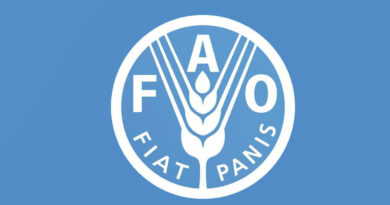Innovation to counter food supply-chain disruptions and spur recovery
19 January, 2021, Rome/Berlin: Innovative solutions in agri-food systems helped households and countries contain disruptions in food supply chains during the COVID-19 pandemic, and more will be required to “build back better and build back greener”, FAO’s Director-General QU Dongyu said today.
Innovation occurs on the technology frontier but also in policy making and business models, he emphasized while speaking at a virtual high-level panel on how to help strengthen the sustainability of food systems and prevent future pandemics.
Also Read: Early, positive start to New Zealand export onion season
The event was organized by FAO as part of the week-long Global Forum for Food and Agriculture (GFFA) in Berlin. Other participants included Julia Klöckner, Germany’s Federal Minister of Food and Agriculture, Thoko Didiza, South Africa’s Minister of Agriculture, Land Reform and Rural Development, Jamshid Khodjaev, Uzbekistan’s Agriculture Minister, Christian Hofer, Director of Switzerland’s Federal Office for Agriculture, and Erik Fyrwald, Chief Executive Officer of Syngenta Group, a leading seed and crop-production company.
Examples of innovation supported agri-food systems include green channels connecting fresh food producers with urban centers, e-commerce solutions deployed across the spectrum of agri-food systems, and workarounds that have assured the functioning of food safety practices amid widespread restrictions on the movement of people triggered by the COVID-19 emergency.
Lockdowns made people more dependent on the digital business model, Qu said, noting applications along the chain from “the farmer’s field to the consumer’s plate”. The point is to encourage efficiency, effectiveness and agility in actions and responses across the spectrum, he stressed.
In the wake of the pandemic and associated restrictions on the movement of people and goods, FAO led a worldwide effort to mitigate potential food price volatility and the risk of trade restrictions, organized and supported innovative institutional approaches – including an African Union Tripartite Ministerial Meeting spurring coherent integration of the agriculture, trade and finance policy portfolios of Members, and rolled out its Hand-in-Hand Initiative with the novel Geospatial Platform and Big Data lab.
“Innovation isn’t some theoretical idea – it’s a reality,” the Director-General said.
Looking ahead, FAO’s COVID-19 Response and Recovery Programme, identifies as drivers: data for decision-making, social protection programs, boosting smallholder resilience, empowering rural women, trade facilitation and market transparency as well as the One Health approach – promoted jointly with the World Health Organization and the World Organisation for Animal Health (OIE) – integrating human and animal disease strategies with those for protecting biodiversity and natural resources.
FAO is also improving real-time tools, using novel inputs such as satellite imagery to machine-learning, to calibrate and classify crop prospects and monitor disruption risks to food production and trade. That, and the International Platform for Digital Food and Agriculture, welcomed in last year’s GFFA ministerial meeting and now being set up by FAO, can also help provide crucial support for Members implementing the One Health approach as well as boost productivity in general, the Director-General said.
The GFFA
Organized by the German Federal Ministry for Food and Agriculture, the Global Forum for Food and Agriculture (18-22 January) is one of the sector’s biggest events. It will conclude with a ministerial conference attracting international organizations’ chiefs and over 80 agriculture ministers. The overarching theme for this year’s conference is how to feed the world in times of pandemics and climate change.
FAO organized two expert panels and its experts participated in others, including two of the opening sessions hosted by the Committee on World Food Security (CFS), a multi-stakeholder platform that develops and endorses policy recommendations and guidance on a wide range of food security and nutrition topics.
CFS Chair Thanawat Tiensin participated, along with FAO Senior Economist Andrea Cattaneo, in Monday’s panel focusing on the role of water as the primary medium through which we will feel the effects of climate change. Challenges related to water scarcity was the focus of FAO’s flagship The State of Food and Agriculture report in 2020.
Boubaker Ben Belhassen, Director of FAO’s Markets and Trade Division, participated in another opening panel on lessons learned during the COVID-19 emergency for resilience building among agricultural value chains.
Earlier Tuesday, FAO hosted an expert panel on how to enhance the resilience of city region food systems in the face of pandemics and climate change. Some 80 percent of all food produced is destined for consumption in urban spaces, putting a premium on robust management of agri-food systems both in cities and their surrounding areas. The event was moderated by Guido Santini, Coordinator for FAO’s City Region Food Systems Programme and core group member of the FAO Green Cities Initiative, which with the support of Germany is implementing initiatives in 8 different cities around the world.
Need for innovation in livestock systems
FAO’s livestock experts presented a new report on opportunities for innovation in livestock systems to tackle both pandemics and climate change.
The report notes that an encompassing priority is to make livestock systems – which are often associated with GHG emissions, zoonotic disease spillover risks and burgeoning use of anti-microbial agents but are also critical suppliers of animal protein and support hundreds of millions of livelihoods – greener, safer and more equitable.
The detailed report emphasizes the need for a robust One Health approach that allows animal-health measure and surveillance schemes to contribute to early-warning systems for emerging pathogens, the bolstering of equity to assure market access for vulnerable smallholders, supply-chain diversification and improved cold-chain infrastructure to optimize incomes and reduce food loss and waste, as well as land restoration, biodiversity protection, low-carbon techniques and innovations in livestock feed and productivity.















